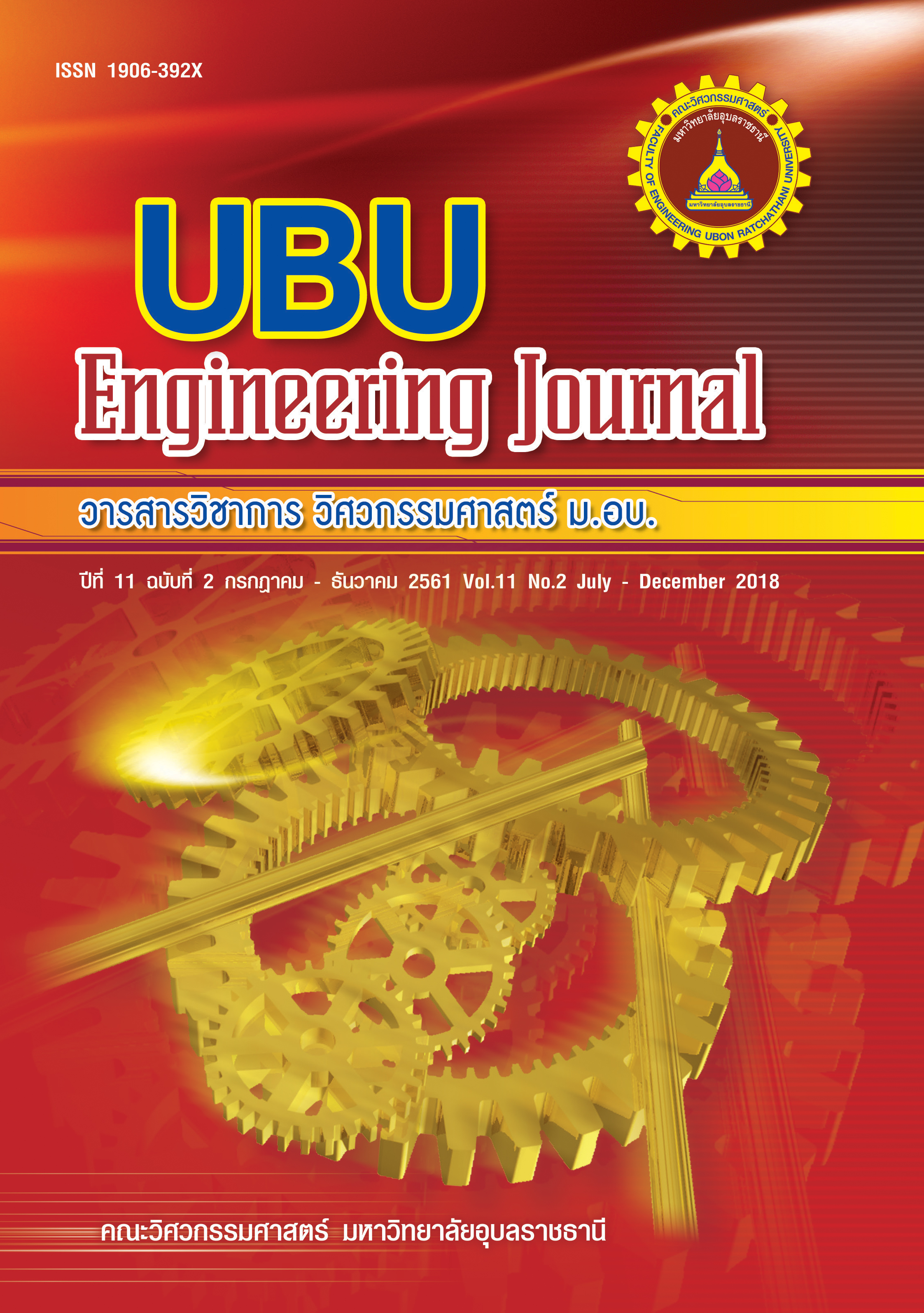การศึกษาความเป็นไปได้ของการผลิตไฟฟ้าด้วยเทอร์โมอิเล็กทริกจากเตาย่าง
Main Article Content
Abstract
Nowadays, a grill is widely used in the rural areas in Thailand. Therefore, this research studied the feasibility of attaching a Thermoelectric Generator Module (TEG) on a wall of the grill and investigated an optimum temperature for its installation. In this research, the hot side of the TEG was attached on the grill and the cold side had a ventilating fan by controlling the wind direction at the heat sink. The ventilating fan was installed at the suitable position at the side of the grill. The experiment showed that the temperatures of the cold and hot sides were measured at 53.2 °C and 150.9 °C, respectively. The difference of the highest and lowest temperatures was 97.7 °C, which generated power output and efficiency conversion at 2.05 W and 2.22% per module, respectively. An economic analysis indicated a payback period is 1.74 year. The power output from one TEG module can be supplied to an incandescent light bulb or charged a battery.
Article Details
References
[2] Loh SK. The potential of the Malaysian oil palm biomass as a renewable energy. Source Energy Conversion and Management. 2017; 141: 285– 298.
[3] Abbasi SA, Abbasi T, Abbasi T. Impact of windenergy generation on climate: A rising spectre. Renewable and Sustainable Energy Reviews. 2016; 59: 1591–1598.
[4] He W, Su Y, Wang YQ. Riffat SB, Ji J. A study on incorporation of thermoelectric modules with evacuated-tube heat-pipe solar collectors. Renewable Energy. 2012; 37: 142–149.
[5] Hsu CT, Huang GY, Chu HS, Yu B, Yao DJ. An effective Seebeck coefficient obtained by experimental results of a thermoelectric generator module. Applied Energy. 2011; 88: 5173–5179.
[6] Sahin AZ, Yilbas BS, Shuja SZ, Momin O. Investigation into topping cycle: Thermal efficiency with and without presence of thermoelectric generator. Journal of Energy. 2011; 36: 4048–4054.
[7] Radion C. Theoretical studies on the efficiency of air conditioner based on permeable thermoelectric converter. Journal of Applied Thermal Engineering. 2012; 38(4): 7–13.
[8] Bamroongkhan P, Lertsatitthanakorn C. Performance Study of a Thermoelectric Generator Incorporated in a Liquid Petroleum Gas Stove. In: Burapha University International Conference July 3–4; 2014.
[9] Eakburanawat J, Boonyaroonate I. Development of a thermoelectric battery-charger with microcontroller-based maximum power point tracking technique. Applied Energy. 2006; 83: 687–704.
[10] Lertsatitthanakorn C. Electrical performance analysis and economic evaluation of combined biomass cook stove thermoelectric (BITE) generator. Bioresource Technology. 2007; 98: 1670–1674.
[11] Lertsatitthanakorn C, Jamradloedluk J, Rungsiyopas M. Study of Combined Rice Husk Gasifier Thermoelectric Generator. Energy Procedia. 2014; 52: 159–166.
[12] ปวัฒวงศ์ บำรุงขันท์, เจริญพร เลิศสถิตธนกร ทางเลือก ในการระบายความร้อนสำหรับการผลิตไฟฟ้าจากเธอร์ โมอิเล็กทริก. วิศวกรรมสารมหาวิทยาลัยเกษตรศาสตร์. 2559; 29(97): 87–94.
[13] Elsheikh MH, et al. A review on thermoelectric renewable energy: Principle parameters that affect their performance. Renewable and Sustainable Energy Reviews. 2014; 30: 337–355.
[14] Miller EW, Hendricks TJ, Peterson RB. Modeling Energy Recovery Using Thermoelectric Conversion Integrated with an Organic Rankine Bottoming Cycle. Journal of ELECTRONIC MATERIALS. 2009; 38: 1206–1213.
[15] Newnan DG. Engineering Economic Analysis. Engineering Press Inc: California; 1980.

